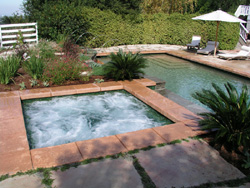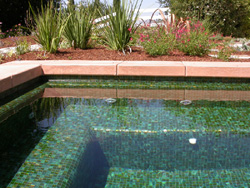USA Today Lifestyle - Hot tubs help water down stress

Posted 5/7/2004
Hot tubs help water down stress
By Marco R. della Cava Gannett News Service
LOS ALTOS, Calif. -- In the back yard of a sprawling rambler high above Silicon Valley is a hole in the ground filled with water.
Admire it. Criticize it. Envy it. Just don't call it a hot tub.
The correct term is "spa" -- as in spare no expense to make your outdoor living space as spectacular as its indoor counterpart. As in price tags ranging from $30,000 to $200,000 for in-ground works of aquatic art that incorporate lasers,
fire, even Federal Aviation Administration-rated sonar equipment. 
"We put a lot of effort and money into remodeling our home, so extending that to the yard seemed natural," says Julia Roever, who adds that husband Stefan's passion for swimming laps in the adjacent pool also inspired them to add a muscle-relaxing spa.
"The key was to make sure it looked integrated into the landscape."
Shortly after buying the house -- the couple recently moved from Germany when Stefan, a software engineer, founded a company -- a call went out to Paul Benedetti, owner of Aquatic Technology in nearby Morgan Hill. After a brainstorming session, the Roevers settled on a square, 12-person spa with waterfall spillways that cascade into the pool.
The spa's shimmering green glass tiles, from upscale Italian manufacturer Bisazza, were flown in. The spa's seating area has different heights to accommodate JU6-foot parents as well as the couple's school-age children. Powerful jets were arrayed in just the right spots for maximum water therapy.
Then there's the sonar touch, derived from the same technology employed in airplane cockpit "black boxes." Set 18 inches below water level are a series of round knobs that create a plane of sound waves. When that is broken -- notably by a child who has fallen in -- an alarm sounds inside the house.
For a final touch, Benedetti installed pumps in the surrounding landscaping, which shoot solid, arcing rods of water into the pool. At night, lasers shoot light through each stream of water, a touch of Vegas in your own yard.
"I have this at my home, too," says Benedetti, ever the pool guy in flip-flops and surfer shades. "But I have to be honest: It only goes on when I want to show off." 
But more homeowners want to do just that. The spa business has been growing at a 15 percent annual clip for the past several years, says Suzanne Barrows of the National Spa & Pool Institute.
"The biggest increase is in the high-end segment," Barrows says. "People seem to think less about traveling and more about putting that money in the back yard."
Among the most popular spa accessories: DVD players, surround sound and built-in tables for playing cards or board games while your calves get jetted.
"No question, the thinking on these things has evolved from the days everyone thought they were just to have sex in," says Brian Van Bower of Miami's Aquatic Consultants. "Some people seem to go for this because they feel (water therapy) will help them live longer, and others just do it for the aesthetics."
He recently installed a black granite and tile spa featuring perimeter-overflow architecture -- picture a tub within a tub, with water in the inner tub constantly spilling over into the outer. There also is a fire feature located safely behind the tub, whose flames are reflected on the water surface.
As with all luxury, spa designs are limited only by your wallet.
Want to be able to stand in your spa? Just ask for one corner to be dug 5 feet, and add appropriately positioned jets to massage the entire body. Concerned about that hot-tub bugaboo, germ-filled water? State-of-the-art pump and filtration systems virtually eliminate that issue.
Though above-ground spas -- a nice one will run you around $8,000 -- offer a cheaper way to enjoy the spa experience, those who opt for custom-built solutions are looking for outdoor statements, says David Tisherman of David Tisherman's Visuals in Manhattan Beach, Calif., and Cherry Hill, N.J.
"My clients are buying art," he says. "A water effect is 65 percent visual because you're really only in there about 35 percent of the time, at most. I'm getting away from the body-part notion of water features, pools shaped like kidneys and all that, and moving upscale. It's the difference between tennis shoes and elegant dress shoes."
Tisherman's projects, which can top $200,000, often use an array of different surface materials that include glass, tile, granite and mosaics. By using high-end pumps and pipes, he can speed up the rate at which spas heat up or subtly vary each jet's massage effect.
"A well-thought-out spa can be so beautiful and relaxing," he says. "Everyone likes to hear water. But you want the spa to sound like that stream you dream of and not Niagara Falls."
Between its spillways and arcing tubes of water, the Roevers' spa certainly qualifies as a little piece of Canyon Ranch in Northern California. Although the price tag hit the mid-five figures, there are no second thoughts.
"The whole family uses it," Julia Roever says. "And besides, coming from cool Germany to sunny California, it just seemed like something we had to do. It fits the dream."
Like many '70s cultural miscues, from disco to the AMC Pacer, hot tubs have some explaining to do. Time was when those bubbles were synonymous with altered-state sexcapades. Think Hugh Hefner's infamous grotto.
But a lot has changed since the concept of stewing in a vat of hot water broke the surface in the '50s, when Northern California vintners cut wine vats in half for their own post-harvest R&R.
Today, hot tubs are a $2.8 billion-a-year market; there are an estimated 6 million tubs in American homes. Last year, 374,000 above- and in-ground tubs were sold, nearly double the rate in 1993.
"The growth in this area is nearly double that of pools," says Suzanne Barrows of the National Spa & Pool Institute. "We get the sense this is only the beginning."
In the past, a new spa manufacturer would produce 200 units a year and go from there. "Today, a startup will put out 25,000 a year just for starters," she says.
For folks ready to move beyond the venerable hot tub, the installation of choice is a swim spa. In addition to traditional spa features, these hybrids have massive jets that produce a current, which allows swimmers to work out without owning full-length lap pools.
"They run around $40,000," Barrows says. "And the companies building them can't install them fast enough."
© Copyright 2004 USA TODAY, a division of Gannett Co. Inc
